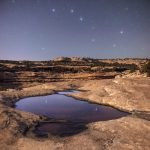
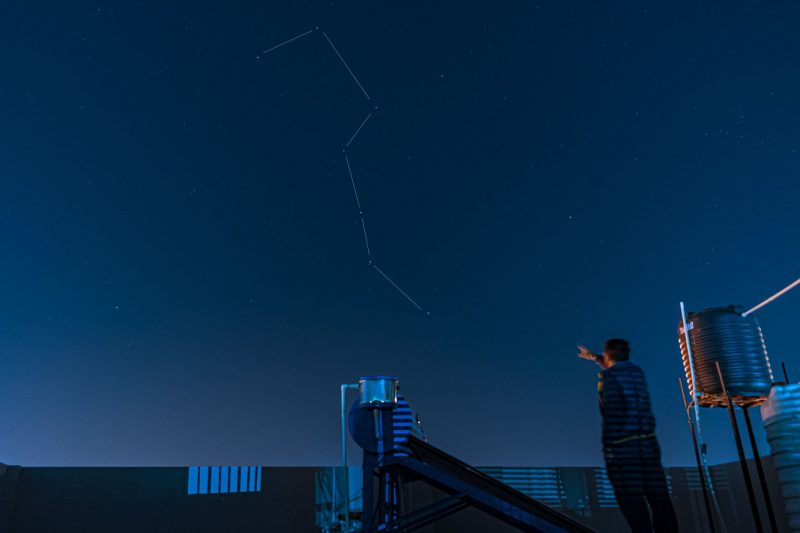
View at EarthSky Community Photos. | Prateek Pandey in Bhopal, Madhya Pradesh, India captured this photo of the Big Dipper on February 2, 2021. As March begins, you’ll find the Big Dipper ascending in the northeast each evening. Thanks, Prateek!
The Big Dipper is one of the easiest star patterns to locate in Earth’s sky. It’s visible just about every clear night in the Northern Hemisphere, looking like a big dot-to-dot of a kitchen ladle. As Earth spins, the Big Dipper and its sky neighbor, the Little Dipper, rotate around the North Star, also known as Polaris. From the northern part of the Northern Hemisphere, the Big and Little Dippers are in the sky continuously, always above your horizon, circling endlessly around Polaris.
If you can spot the Big Dipper, then you’re on your way to finding the Little Dipper and the North Star, Polaris, too.
Just remember the old saying spring up and fall down. On spring and summer evenings in the Northern Hemisphere, the Big Dipper shines at its highest in the evening sky. On autumn and winter evenings, the Big Dipper sweeps closer to the horizon.
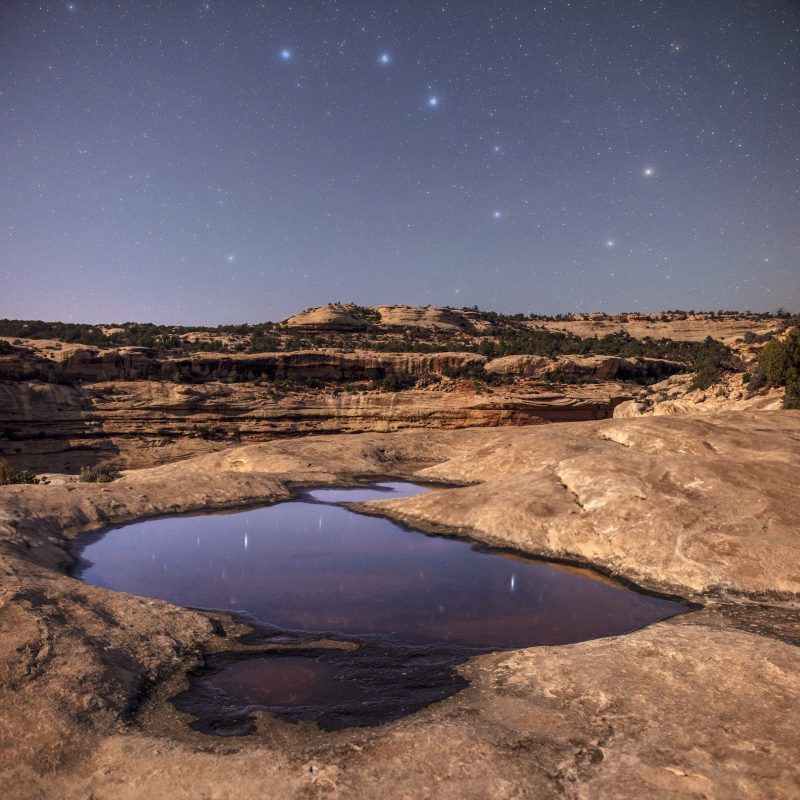
The Big Dipper over a pool in the Utah desert, caught from a canyon littered with the rock art and ruins of Ancestral Puebloans. Image via Marc Toso.
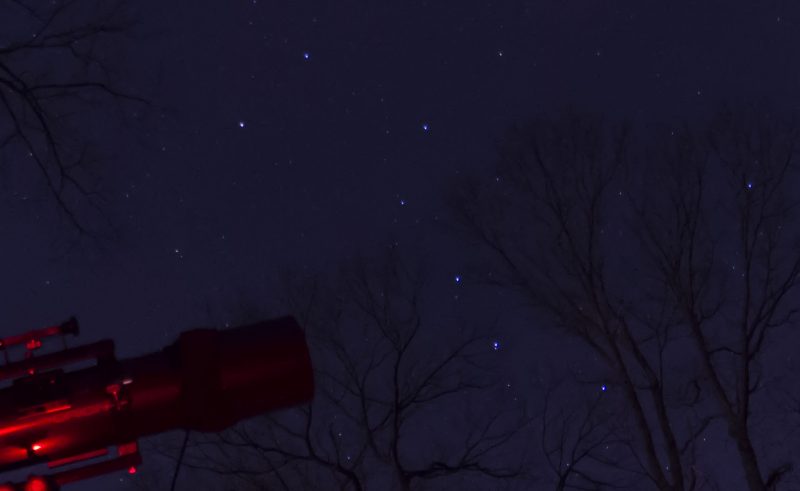
View larger. | The Big Dipper captured in April 2017 by Kurt Zeppetello. If you look closely at the second star of the handle, Mizar, you can see a smaller companion star, Alcor.
Given an unobstructed horizon, latitudes north of the 35th parallel (the approximate location of the Mediterranean Sea and Tennessee’s southern border) can expect to see the Big Dipper at any hour of the night for all days of the year.
As for the Little Dipper, it is circumpolar – always above the horizon – as far south as the Tropic of Cancer (23.5 degrees north latitude).

View larger. | Big and Little Dippers at different seasons, and different times of night, as captured by Matthew Chin in Hong Kong.
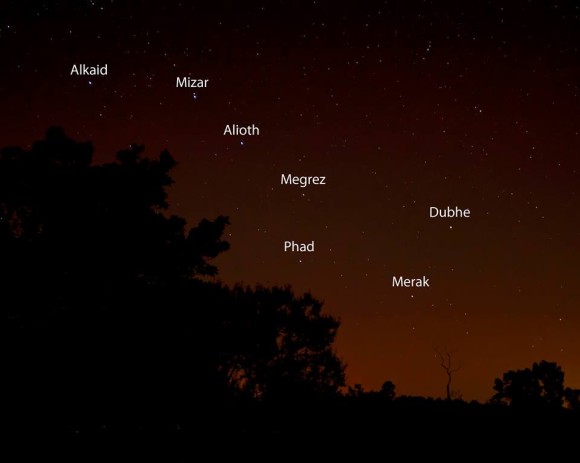
Stars in the Big Dipper via EarthSky Facebook friend Ken Christison. He captured this photo in September 2013.
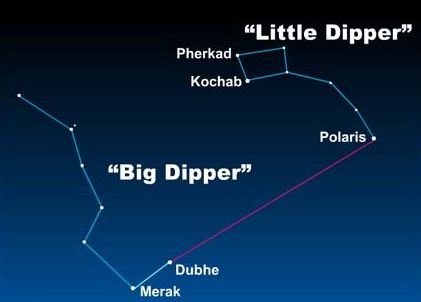
No matter what time of year you look, the two outer stars in the Big Dipper’s bowl always point to Polaris.
Here’s how to find the North Star. The Big Dipper has two parts, a bowl and a handle. Notice the two outer stars in the bowl of the Big Dipper. They are called Dubhe and Merak, and an imaginary line drawn between them goes to Polaris, the North Star. That’s why Dubhe and Merak are known in skylore as The Pointers.
Here’s how to find the Little Dipper. Polaris marks the end of the Little Dipper’s Handle. So why isn’t the Little Dipper as easy to pick out as the Big Dipper? The answer is that the stars between Polaris and the outer bowl stars – Kochab and Pherkad – are rather dim. You need a dark country sky to see all seven of the Little Dipper’s stars.
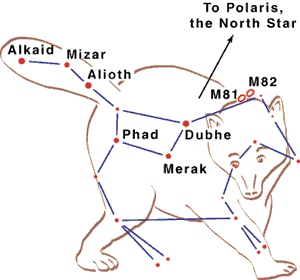
The Big Dipper is part of Ursa Major, the celestial Great Bear. Image via Night Sky Interlude.
The Big Dipper isn’t a constellation. It’s an asterism, or noticeable pattern of stars. The Big Dipper is a clipped version of the constellation Ursa Major the Greater Bear, with the Big Dipper stars outlining the Bear’s tail and hindquarters. In the star lore of the Mi’kmaw nation in northern Canada, the Big Dipper is also associated with a bear, but with a twist. The Mi’kmaw see the Big Dipper bowl as Celestial Bear, and the three stars of the handle as hunters chasing the Bear.
The starry sky serves as a calendar and a story book, as is beautifully illustrated by the Mi’kmaw tale of Celestial Bear. In autumn, the hunters finally catch up with the Bear, and it’s said that the blood from the Bear colors the autumn landscape. In another version of the story, Celestial Bear hits its nose when coming down to Earth, with its bloody nose giving color to autumn leaves. When Celestial Bear is seen right on the northern horizon on late fall and early winter evenings, it’s a sure sign that the hibernation season is upon us.
The Little Dipper is also an asterism, these stars belonging to the constellation Ursa Minor the Little Bear. In ancient times, the Little Dipper formed the wings of the constellation Draco the Dragon. But when the seafaring Phoenicians met with the Greek astronomer Thales around 600 B.C., they showed him how to use the Little Dipper stars to navigate. Thereby, Thales clipped Draco’s wings, to create a constellation that gave Greek sailors a new way to steer by the stars.
In Thales’s day, the stars Kochab and Pherkad (rather than Polaris) marked the approximate direction of the north celestial pole, the point in the sky that is directly above the Earth’s North Pole.
To this day, Kochab and Pherkad are still known as the Guardians of the Pole.
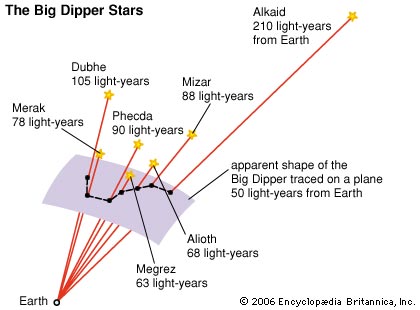
Astronomers have found that the stars of the Big Dipper (excepting the pointer star, Dubhe, and the handle star, Alkaid) belong to an association of stars known as the Ursa Major Moving Cluster. Here are the stars of the Big Dipper, at their various distances from Earth. Image via AstroPixie.
Astronomers sometimes speak of the fixed stars, but know the stars aren’t truly fixed. Stars move in space. Thus the star patterns that we see today as the Big and Little Dippers will, slowly but surely, drift apart over time.
But even 25,000 years from now, the Big Dipper pattern will look nearly the same as its does today. Astronomers have found that the stars of the Big Dipper (excepting the pointer star, Dubhe, and the handle star, Alkaid) belong to an association of stars known as the Ursa Major Moving Cluster. These stars, loosely bound by gravity, drift in the same direction in space.
In 100,000 years, this pattern of Big Dipper stars (minus Dubhe and Alkaid) will appear much as it does today! But there will be some differences, as illustrated in the drawing below:
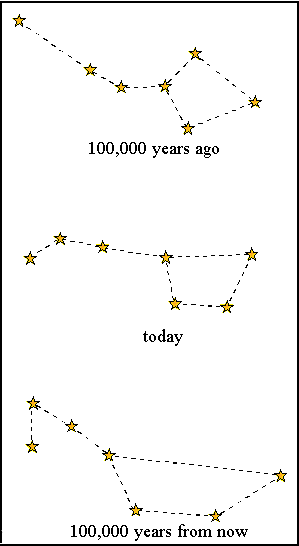
Stars of the Big Dipper 100,000 years ago, today, and 100,000 years from now. Image via AstroPixie.
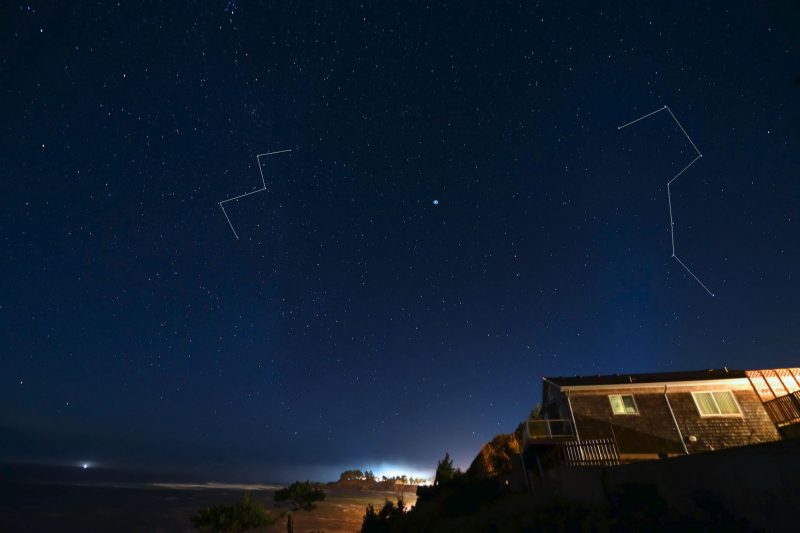
View at EarthSky Community Photos. | Caroline Kennedy in Depoe Bay, Oregon, captured this photo of the Big Dipper and Cassiopeia, with the North Star, Polaris, circled in between. She wrote: “The stars twinkle bright after the moon hid behind the clouds over the Pacific Ocean horizon. There’s the North Star, or Polaris, between Cassiopeia the Queen and the Big Dipper.” Thanks, Caroline!
Bottom line: You can find the Big Dipper and Little Dipper in northern skies any time of year. The North Star, Polaris, is located at the end of the Little Dipper’s handle.
from EarthSky https://ift.tt/2UcDIP0


View at EarthSky Community Photos. | Prateek Pandey in Bhopal, Madhya Pradesh, India captured this photo of the Big Dipper on February 2, 2021. As March begins, you’ll find the Big Dipper ascending in the northeast each evening. Thanks, Prateek!
The Big Dipper is one of the easiest star patterns to locate in Earth’s sky. It’s visible just about every clear night in the Northern Hemisphere, looking like a big dot-to-dot of a kitchen ladle. As Earth spins, the Big Dipper and its sky neighbor, the Little Dipper, rotate around the North Star, also known as Polaris. From the northern part of the Northern Hemisphere, the Big and Little Dippers are in the sky continuously, always above your horizon, circling endlessly around Polaris.
If you can spot the Big Dipper, then you’re on your way to finding the Little Dipper and the North Star, Polaris, too.
Just remember the old saying spring up and fall down. On spring and summer evenings in the Northern Hemisphere, the Big Dipper shines at its highest in the evening sky. On autumn and winter evenings, the Big Dipper sweeps closer to the horizon.

The Big Dipper over a pool in the Utah desert, caught from a canyon littered with the rock art and ruins of Ancestral Puebloans. Image via Marc Toso.

View larger. | The Big Dipper captured in April 2017 by Kurt Zeppetello. If you look closely at the second star of the handle, Mizar, you can see a smaller companion star, Alcor.
Given an unobstructed horizon, latitudes north of the 35th parallel (the approximate location of the Mediterranean Sea and Tennessee’s southern border) can expect to see the Big Dipper at any hour of the night for all days of the year.
As for the Little Dipper, it is circumpolar – always above the horizon – as far south as the Tropic of Cancer (23.5 degrees north latitude).

View larger. | Big and Little Dippers at different seasons, and different times of night, as captured by Matthew Chin in Hong Kong.

Stars in the Big Dipper via EarthSky Facebook friend Ken Christison. He captured this photo in September 2013.

No matter what time of year you look, the two outer stars in the Big Dipper’s bowl always point to Polaris.
Here’s how to find the North Star. The Big Dipper has two parts, a bowl and a handle. Notice the two outer stars in the bowl of the Big Dipper. They are called Dubhe and Merak, and an imaginary line drawn between them goes to Polaris, the North Star. That’s why Dubhe and Merak are known in skylore as The Pointers.
Here’s how to find the Little Dipper. Polaris marks the end of the Little Dipper’s Handle. So why isn’t the Little Dipper as easy to pick out as the Big Dipper? The answer is that the stars between Polaris and the outer bowl stars – Kochab and Pherkad – are rather dim. You need a dark country sky to see all seven of the Little Dipper’s stars.

The Big Dipper is part of Ursa Major, the celestial Great Bear. Image via Night Sky Interlude.
The Big Dipper isn’t a constellation. It’s an asterism, or noticeable pattern of stars. The Big Dipper is a clipped version of the constellation Ursa Major the Greater Bear, with the Big Dipper stars outlining the Bear’s tail and hindquarters. In the star lore of the Mi’kmaw nation in northern Canada, the Big Dipper is also associated with a bear, but with a twist. The Mi’kmaw see the Big Dipper bowl as Celestial Bear, and the three stars of the handle as hunters chasing the Bear.
The starry sky serves as a calendar and a story book, as is beautifully illustrated by the Mi’kmaw tale of Celestial Bear. In autumn, the hunters finally catch up with the Bear, and it’s said that the blood from the Bear colors the autumn landscape. In another version of the story, Celestial Bear hits its nose when coming down to Earth, with its bloody nose giving color to autumn leaves. When Celestial Bear is seen right on the northern horizon on late fall and early winter evenings, it’s a sure sign that the hibernation season is upon us.
The Little Dipper is also an asterism, these stars belonging to the constellation Ursa Minor the Little Bear. In ancient times, the Little Dipper formed the wings of the constellation Draco the Dragon. But when the seafaring Phoenicians met with the Greek astronomer Thales around 600 B.C., they showed him how to use the Little Dipper stars to navigate. Thereby, Thales clipped Draco’s wings, to create a constellation that gave Greek sailors a new way to steer by the stars.
In Thales’s day, the stars Kochab and Pherkad (rather than Polaris) marked the approximate direction of the north celestial pole, the point in the sky that is directly above the Earth’s North Pole.
To this day, Kochab and Pherkad are still known as the Guardians of the Pole.

Astronomers have found that the stars of the Big Dipper (excepting the pointer star, Dubhe, and the handle star, Alkaid) belong to an association of stars known as the Ursa Major Moving Cluster. Here are the stars of the Big Dipper, at their various distances from Earth. Image via AstroPixie.
Astronomers sometimes speak of the fixed stars, but know the stars aren’t truly fixed. Stars move in space. Thus the star patterns that we see today as the Big and Little Dippers will, slowly but surely, drift apart over time.
But even 25,000 years from now, the Big Dipper pattern will look nearly the same as its does today. Astronomers have found that the stars of the Big Dipper (excepting the pointer star, Dubhe, and the handle star, Alkaid) belong to an association of stars known as the Ursa Major Moving Cluster. These stars, loosely bound by gravity, drift in the same direction in space.
In 100,000 years, this pattern of Big Dipper stars (minus Dubhe and Alkaid) will appear much as it does today! But there will be some differences, as illustrated in the drawing below:

Stars of the Big Dipper 100,000 years ago, today, and 100,000 years from now. Image via AstroPixie.

View at EarthSky Community Photos. | Caroline Kennedy in Depoe Bay, Oregon, captured this photo of the Big Dipper and Cassiopeia, with the North Star, Polaris, circled in between. She wrote: “The stars twinkle bright after the moon hid behind the clouds over the Pacific Ocean horizon. There’s the North Star, or Polaris, between Cassiopeia the Queen and the Big Dipper.” Thanks, Caroline!
Bottom line: You can find the Big Dipper and Little Dipper in northern skies any time of year. The North Star, Polaris, is located at the end of the Little Dipper’s handle.
from EarthSky https://ift.tt/2UcDIP0

Aucun commentaire:
Enregistrer un commentaire